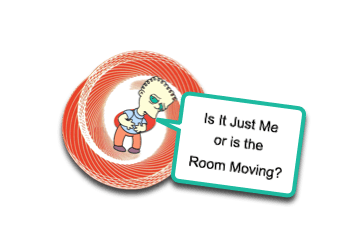Vertigo in Children

Vertigo: Basics
- Dizziness is a common complaint. [Davitt, 2017]
- Vertigo is an illusion of motion.
- May be described as a “spinning” or “whirling.”
- “Dizzy” is often the initial complaint, but it is not descriptive enough to be overtly helpful.
- Unfortunately, children may lack the vocabulary to better describe their feelings.
- Children may also lack the experience to understand their sensations.
- Children vs Adults
- Children will have a more difficult time describing symptoms (although, not all adults are proficient in verbal communication of their symptoms either).
- Children may be more difficult to appreciate their nystagmus.
- Children will be more likely have vertigo related to migraines.
- Children will be less likely to have Meniere’s disease.
- Children will be less likely to have vascular etiology.
Vertigo: Causes
Vertigo in children “does not commonly represent a life-threatening or serious illness.” [Davitt, 2017]
Common Causes in children who have normal tympanic membranes. [Davitt, 2017; Raucci, 2016; Erbek, 2006]
- Migraine-Associated Vertigo [Davitt, 2017; Raucci, 2016; Erbek, 2006]
- Most common condition associated with vertigo (other than Otitis Media)
- Vertigo may present before, during, or without headache.
- Neuro exam should be normal.
- More common in children than adults.
- Benign Paroxysmal Vertigo of Childhood (BPVC)
- Recurrent, brief attacks of vertigo.
- Attacks occur without warning and resolve spontaneously.
- Typically seen in children < 5 years of age. [Raucci, 2016]
- Can be associated with pallor, perspiration, fearfulness, nausea, vomiting, phonophotophobia, and syncope. [Batu, 2015; Erbek, 2006]
- Vertigo does not have relation to head position (different from BPPV).
- Vertigo is not associated with loss of consciousness (different from seizure)
- Has a favorable prognosis and resolves after 6-12 months.
- May be a part of a migraine complex, like cyclic vomiting and abdominal migraine.
- Seizure
- Loss of consciousness associated with vertigo warrants consideration of seizure as cause.
- Staring episodes are also seen. [Batu, 2015]
- Labyrinthitis / vestibular neuronitis
- Follows an upper respiratory tract infection frequently
- Syncope / Orthostatic hypotension / POTS
- Psychogenic
- More prevalent in older children (> 10 years of age)
- It is always reasonable to screen for underlying psychiatric disorders.
- Vertigo associated with anxiety, depression, and behavior disorders are seen. [Erbek, 2006]
- Benign Paroxysmal Peripheral Vertigo (BPPV) [Brodsky, 2017]
- Consists of short-duration vertigo attacks related to head position.
- Less common in children than adults, but does occur.
- More likely to be seen in teenagers.
- Ocular Causes
- Amblyopia
- Astigmatism
- Oculomotor abnormalities
- Many encounters will ultimately be described as “Idiopathic“
Uncommon, But Concerning Causes
Life-threatening disorders presenting with vertigo do occur, but “appear at an extremely low rate.” [Davitt, 2017]
- Trauma
- Skull fractures
- Cardiac Causes
- Arrhythmias (ex, Prolonged QTc)
- Hypertension
- CNS Causes
- Tumors
- Demyelinating disease
- Fortunately, patients “in whom severe neurological pathologies were diagnosed presented with associated signs or symptoms” and vertigo was not an isolated clinical feature. [Raucci, 2016]
Vertigo: Evaluation in the ED
Since the overwhelming majority of cases of vertigo in children will be due to a benign etiology, it is our job to mindfully screen for the rare, life-threatening conditions while being reasonable guardians of our resources.
- A thorough Neurologic and HEENT exam is imperative. [Raucci, 2016; Erbek, 2006]
- Otitis is a very common cause of vertigo (~50%)… don’t overlook the simple.
- Episodes of unsteadiness may be the child exhibiting symptoms of vertigo. [Batu, 2015]
- Check the Blood Pressure. [Raucci, 2016; Batu, 2015]
- Seems simple… but it is also easy to overlook.
- While rare, hypertensive crisis may present with vertigo… so check the BP.
- Check the ECG. [Batu, 2015]
- While the likelihood of a cardiac cause is low, don’t underestimate the power of a simple piece of paper with squiggly lines on it.
- Look for arrhythmia provoking conditions (ex, Prolonged QTc, Brugada)
- Imaging?
- It is unlikely that a head CT will be of much value unless your neurologic exam is concerning for hemorrhage or overt mass.
- MRI will be more useful at imaging the posterior fossa and demyelinating disease… but, with the majority of cases being due to benign and self-limited conditions, emergent imaging is rarely beneficial. [Raucci, 2016; Batu, 2015]
- Outpatient Referral
- Recommend ophthalmological evaluation as outpatient. [Batu, 2015]
- Refractory errors may be the cause of vertigo…
- They can also exacerbate vertigo even if they are not the cause.
- Referral to multidisciplinary team may be beneficial. [Erbek, 2006]
- Outpatient EEG and MRI may be warranted for evaluation of possible seizures.
- Other benign conditions, like migraines and BPVC, have medical therapies available.
- Recommend ophthalmological evaluation as outpatient. [Batu, 2015]
Moral of the Morsel
- The Odds are in Your Favor! Most vertigo in children is related to benign causes (ex, migraines).
- Don’t overlook the obvious! Check the TMs. Look for trauma.
- Do simple screening! Check the ECG and BP!
- Look for signs of underlying Neurological or Cardiac causes.


Thanks Dr. Fox for a simplified approach to child with vertigo
excellent Topix
[…] 1 https://pedemmorsels.com/vertigo-in-children/ […]
Having a child in pain can be heartbreaking to watch, even more so when they exhibit symptoms we may be unfamiliar with. Complaints of dizziness and nausea for short periods of time can be confusing, and we don’t think of children as having issues with vertigo.